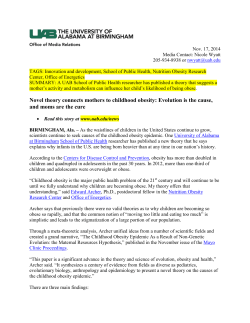
The biggest loser things long-term
The biggest loser thinks long-term: Decision-making predictors of weight-management success Gilly Koritzky, Ph.D. Obesity: a prominent public health problem Obesity and its adverse effects on health have become prevalent worldwide (USA: Over 30% of adults are obese). Even a small weight loss of 5% is considered beneficial (CDCP). Weight management is about making better choices. The Neuroscience of Eating-Related Decisions Obesity (like addiction) is affected by the joint activity of two brain systems: Motivation Reflection, Self-control Long-term considerations, planning, inhibitory control. Drives, craves related to incentives and rewards. Predicting success in weight management Weight-management interventions are mostly ineffective. • Attrition is a common problem; 32% on average (Moroshko et al., 2011) • Only ~25% of dieters lose as much as 5% of their weight (Appel et al., 2011; Johnson et al., 2008). Commonly reported correlates: Younger age (attrition), female gender (attrition), lower education level, numerous past weight-loss attempts, unrealistic weight-loss expectations, low body image. No consistent set of predictors has been identified. Theory-driven explanations are scarce. Prediction based on decision making style Understanding the “cognitive risk factors” should enhance professionals’ ability to increase completion rates and improve health outcomes for more individuals. A focus on individual differences. The Expectancy-Valence (EV) Model Busemeyer & Stout, 2002 Captures three underlying components of behavior in decision tasks that involve repeated selection between alternatives. • The subjective sensitivity to gains vs. losses. • The person’s recency = how much she/he is affected by new information. • The person’s consistency = how likely she/he is to prefer the highestexpectancy alternative (probabilistic). Individual parameters are estimated via an analysis of trial-to-trial choice making. Recency Reflection (Koritzky et al., 2013) Sensitivity to gain/loss Drive, reward (Premkumar et al., 2008; Chan et al., 2014) Method Participants: Clients in evidence-based weight-management program. • 80% women • Mean age: 44 • Mean initial weight: 207 lbs; Body Mass Index: 34.11 (SD=7.06). 16 weeks long; weekly meetings with therapists. You won: 100, You lost: 250 We measured decision making and analyzed the results using the EV Model. Attrition study* N=52 ; 35% attrition No differences in initial weight, BMI, age, employment status, or number of prior weight-loss attempts (education level: marginally significant). Completers N=34 Dropouts N=18 Recency 0.25 (0.37) 0.25 (0.36) Weight Gains/ Losses * 0.57 (0.30) 0.72 (0.22) Consistency 3.28 (3.18) 3.57 (1.68) * p < 0.05, two-sample t-test. * Published as: Koritzky, Dieterle, Rice, Jordan, & Bechara (2014). Decision making, sensitivity to reward, and attrition in weight management. Obesity, 22, 1904-1909. Weight loss N=43 completers of the program (≥12 weeks) No differences in initial weight, BMI, age, employment status, or education level. A difference in # of prior weight-loss attempts. Unsuccessful n=31 Successful n=12 Recency* 0.43 (0.43) 0.11 (0.36) Weight Gains/ Losses Consistency 0.57 2.55 (0.33) (2.50) 0.56 4.01 (0.25) (4.00) * p < 0.05, two-sample t-test. Connecting the dots Weight loss Attrition Recency Sensitivity to gain Reflection (Koritzky et al., 2013) Drive, reward (Premkumar et al., 2008; Chan et al., 2014) Gilly Koritzky koritzky@usc.edu Obesity and Gender Drive, reward Linked with Obesity? E.g., Davis et al., 2007; Nederkoorn et al., 2006. The sample Obese 30 ≤ BMI Control 20≤BMI<25 40 36 19 (48%) 17 (47%) Height inch 5’ 7” (3.9) 5’ 8” (3.2) Weight lbs 224.52 (31.5) 149.9 (15.5) BMI 34.69 (3.67) 22.8 (1.58) N Women Measures of the Drive/Reward System The Impulsiveness Questionnaire (Eysenck et al., 1985). “Do you often buy things on impulse?" "Do you generally do and say things without stopping to think?” ANOVA 12 Rate on Impulsiveness scale Yes/ No Interaction: Obese Normal weight 10 F(1,72)=6.33, p=0.014 8 6 4 2 0 Men Women Delay of Gratification Task (Newman et al., 1992) Win 5 NIS: 80% 5 40% Obese Normal weight Prop. of delayed button choice 10 sec ANOVA 100% Interaction: 80% F(1,61)=4.41, p=0.04 60% 40% 20% 0% Men Women Obesity and Gender Reflection Linked with Obesity? No evidence (e.g., Davis et al., 2010). Studies on drug addiction show such links in men (e.g., Bechara et al., 2001; Lane et al. 2004). The risk taking task (after Lane et al., 2004) Will obese men display high risk taking (low Reflective-system activity)? % of risky choices Obese Normal weight 60% ANOVA 50% Interaction: 40% F(1,72)=9.75, p=0.003 30% 20% 10% 0% Men Women These findings suggest that the “cognitive profile” of obese men and women is not the same.* Reflection Drive, reward * Published as: Koritzky, Yechiam, Bukay, & Milman, (2012). Obesity and risk taking: A male phenomenon. Appetite, 59, 289–297. Obese Non obese Obese Men and Women Differ in Brain-Activation Patterns Related to Decision Making: A Pilot Study Obese Women Obese Men
© Copyright 2025





















